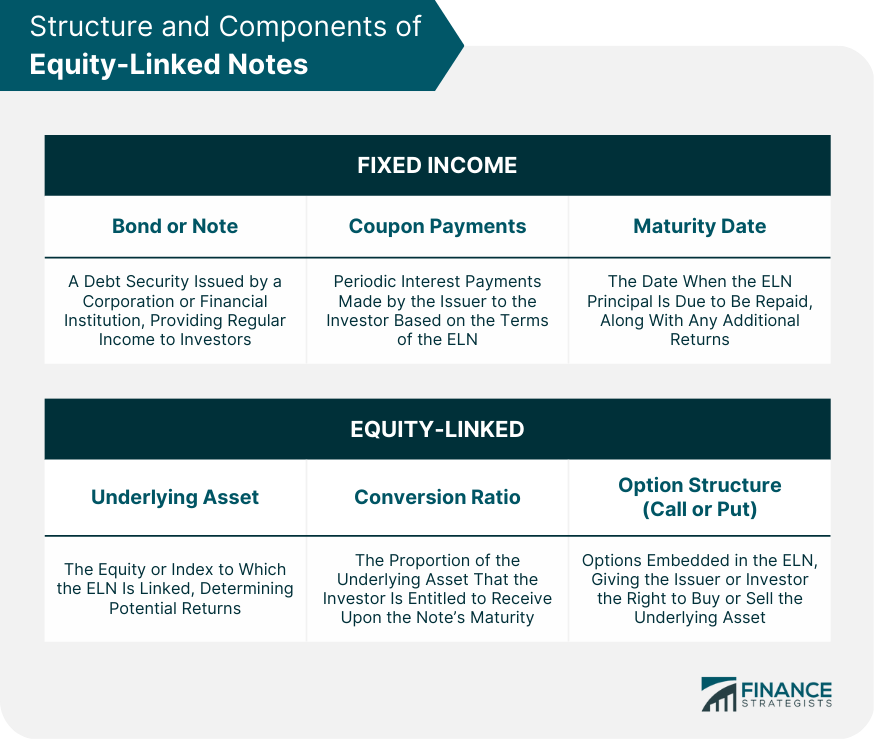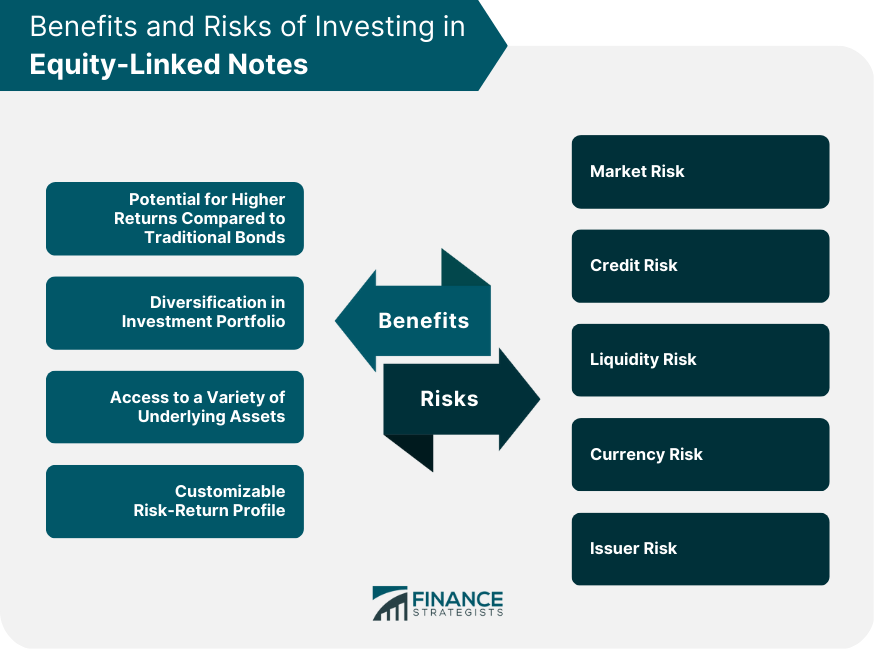Equity-Linked Notes are structured financial instruments that combine the features of both fixed-income securities and equities. They provide investors with the potential for higher returns linked to the performance of an underlying equity or equity index, while still offering regular income through coupon payments. ELNs are popular among investors who seek to enhance their portfolio returns by gaining exposure to equities, without the full risk associated with direct investments. They offer a customizable risk-return profile, allowing investors to strike a balance between the potential for higher returns and the level of risk they are willing to take on. ELNs consist of two main components: a fixed income component in the form of a bond or note, and an equity-linked component tied to the performance of an underlying asset, such as a stock or index. The potential return on investment from ELNs is dependent on the performance of the underlying asset, and the specific terms and conditions of the note. Principal-protected ELNs guarantee the return of the initial investment amount at maturity, regardless of the performance of the underlying asset. This feature makes them attractive to conservative investors who want to preserve their capital while still benefiting from potential gains in the equity market. Non-principal protected ELNs do not guarantee a return on the initial investment. The investor's principal is at risk, and the final payout is dependent on the performance of the underlying asset. These notes offer the potential for higher returns but also carry higher risks compared to principal-protected ELNs. Hybrid ELNs combine features from both principal-protected and non-principal-protected ELNs. They may offer partial principal protection or other variations in their structures, allowing for a range of risk-return profiles to suit different investor preferences. The fixed income component of an ELN is typically a bond or note issued by a corporation or financial institution. This component is responsible for providing regular income through coupon payments. Coupon payments are the periodic interest payments made by the issuer to the investor. The frequency and amount of these payments depend on the specific terms of the ELN. The maturity date is the date when the ELN principal is due to be repaid. At maturity, the investor will receive the principal amount (or a portion of it, depending on the type of ELN), along with any additional returns linked to the performance of the underlying asset. The equity-linked component of an ELN is tied to the performance of an underlying asset, such as a single stock, a basket of stocks, or an equity index. The return on investment from this component depends on the price movement and performance of the underlying asset. The conversion ratio is the proportion of the underlying asset that the investor is entitled to receive upon the note's maturity. This ratio determines the potential upside from the equity-linked component of the ELN. ELNs may include call or put options, which give the issuer or the investor the right (but not the obligation) to buy or sell the underlying asset at a predetermined price on or before a specified date. The options structure can impact the potential returns and risk profile of the ELN. ELNs offer the possibility of higher returns compared to traditional fixed-income securities, as their returns are linked to the performance of an underlying equity or equity index. ELNs can help investors diversify their portfolios by providing exposure to a variety of underlying assets, including equities and equity indices, without the need for direct investment in individual stocks. ELNs offer investors access to various underlying assets, including stocks, baskets of stocks, and equity indices, which may otherwise be difficult or expensive to access through direct investment. ELNs offer a range of structures and features, allowing investors to customize the risk-return profile according to their investment objectives and risk tolerance. Market risk refers to the potential for losses due to fluctuations in the value of the underlying asset. As ELNs are tied to the performance of an underlying equity or index, they are exposed to the same market risks as direct investments in those assets. Credit risk is the risk that the issuer of the ELN may default on its obligations, such as coupon payments or principal repayment. This risk is particularly relevant for non-investment grade issuers or in cases of economic downturns. Liquidity risk is the risk that an investor may not be able to sell the ELN at a fair price or within a reasonable timeframe due to a lack of market demand. This risk can be higher for certain ELNs, especially those with complex structures or those issued by less-established entities. Currency risk arises when the underlying asset or the ELN itself is denominated in a foreign currency. Fluctuations in exchange rates can impact the value of the investment and its returns. Issuer risk is the risk associated with the specific issuer of the ELN. This can include factors such as the financial health, creditworthiness, and reputation of the issuer, which can impact the overall performance and safety of the investment. Changes in interest rates can impact the price of ELNs, as they affect the fixed income component's value and the cost of options embedded in the equity-linked component. Volatility in the underlying asset's price can influence the price of ELNs, as it affects the value of the embedded options and the perceived risk of the investment. Dividend payments on the underlying asset can impact the price of ELNs, as they may affect the asset's price and the expected returns from the equity-linked component. As the maturity date approaches, the price of ELNs may be affected by changes in the underlying asset's price, interest rates, and the time value of the embedded options. The DCF method involves projecting the future cash flows generated by the ELN, discounting them back to the present value using an appropriate discount rate and summing them up. This method can provide an estimate of the intrinsic value of the ELN. The Black-Scholes model is used to value the equity-linked component of the ELN by calculating the value of the embedded options. By combining the value of the fixed-income component and the equity-linked component, investors can estimate the overall value of the ELN. Individual investors can use ELNs to diversify their investment portfolios, gain exposure to a variety of underlying assets, and customize their risk-return profiles according to their investment goals and risk tolerance. Institutional investors, such as pension funds, insurance companies, and asset managers, may use ELNs to enhance portfolio returns, diversify holdings, and manage risk exposure more effectively. Corporations may issue ELNs as a means of raising capital while offering investors a potentially attractive investment opportunity. By linking the notes to the performance of their stock or an index, corporations can attract investors who are interested in gaining exposure to equities while still receiving periodic income. ELNs are subject to various regulations depending on the jurisdiction in which they are issued and traded. These regulations may govern aspects such as disclosure requirements, investor protection measures, and trading practices. Investors should be aware of the regulatory environment in their respective jurisdictions before investing in ELNs. Interest income from the fixed income component of ELNs is generally subject to income tax. The tax treatment of interest income may vary depending on the investor's tax residency and the jurisdiction where the ELN is issued. Capital gains realized from the sale or redemption of ELNs may be subject to capital gains tax. The specific tax treatment depends on factors such as the investor's tax residency, holding period, and the jurisdiction where the ELN is issued. If the ELN provides exposure to dividend-paying underlying assets, the dividends may be subject to tax. The tax treatment of dividends depends on the investor's tax residency and the jurisdiction where the underlying asset is domiciled. Equity-Linked Notes (ELNs) offer investors a unique opportunity to diversify their portfolios and potentially enhance returns by combining the features of both fixed-income securities and equities. With various types of ELNs available, including principal-protected, non-principal-protected, and hybrid ELNs, investors can find an investment option that aligns with their risk tolerance and financial goals. It is important for investors to understand the potential benefits, risks, and tax implications associated with these instruments, as well as the regulatory environment governing ELNs. By considering factors such as market risk, credit risk, liquidity risk, currency risk, and issuer risk, investors can make more informed decisions about whether ELNs are the right fit for their investment portfolios. By leveraging expert guidance and advice, you can better position your portfolio for long-term success and financial growth. Reach out to a wealth management expert to explore the potential of Equity-Linked Notes and other investment opportunities tailored to your unique financial objectives.Definition of Equity-Linked Notes (ELNs)
Overview of Equity-Linked Notes as Investment Instruments
Key Features of Equity-Linked Notes
Types of Equity-Linked Notes
Principal-Protected ELNs
Non-principal Protected ELNs
Hybrid ELNs
Structure and Components of Equity-Linked Notes

Fixed Income Component
Bond or Note
Coupon Payments
Maturity Date
Equity-Linked Component
Underlying Asset (Equity or Index)
Conversion Ratio
Option Structure (Call or Put)
Benefits of Investing in Equity-Linked Notes

Potential for Higher Returns Compared to Traditional Bonds
Diversification in Investment Portfolio
Access to a Variety of Underlying Assets
Customizable Risk-Return Profile
Risks Associated with Equity-Linked Notes
Market Risk
Credit Risk
Liquidity Risk
Currency Risk
Issuer Risk
Pricing and Valuation of Equity-Linked Notes
Factors Affecting the Price of ELNs
Interest Rates
Volatility
Dividends
Time to Maturity
Valuation Methods
Discounted Cash Flow (DCF) Method
Black-Scholes Option Pricing Model
Use Cases for Equity-Linked Notes
Individual Investors
Institutional Investors
Corporates Seeking to Raise Capital
Regulatory and Tax Considerations
Regulatory Environment for ELNs
Tax Treatment of ELNs
Interest Income
Capital Gains
Dividends
Conclusion
Equity-Linked Notes FAQs
ELNs combine features of fixed income securities and equities, offering regular income through coupon payments and potential returns linked to the performance of an underlying asset, such as a stock or index.
There are three main types of ELNs: principal-protected ELNs, which guarantee the return of the initial investment; non-principal protected ELNs, which do not offer principal protection; and hybrid ELNs, which combine features of both types and may offer partial principal protection or other variations.
The benefits of investing in ELNs include the potential for higher returns compared to traditional bonds, diversification in the investment portfolio, access to a variety of underlying assets, and a customizable risk-return profile.
Risks associated with ELNs include market risk, credit risk, liquidity risk, currency risk, and issuer risk. These risks arise from fluctuations in the value of the underlying asset, the creditworthiness of the issuer, market demand for the notes, exchange rate movements, and the financial health of the issuer.
The tax treatment of ELN returns depends on the investor's tax residency and the jurisdiction where the ELN is issued. Generally, interest income is subject to income tax, capital gains may be subject to capital gains tax, and dividends may be subject to dividend tax.
True Tamplin is a published author, public speaker, CEO of UpDigital, and founder of Finance Strategists.
True is a Certified Educator in Personal Finance (CEPF®), author of The Handy Financial Ratios Guide, a member of the Society for Advancing Business Editing and Writing, contributes to his financial education site, Finance Strategists, and has spoken to various financial communities such as the CFA Institute, as well as university students like his Alma mater, Biola University, where he received a bachelor of science in business and data analytics.
To learn more about True, visit his personal website or view his author profiles on Amazon, Nasdaq and Forbes.











